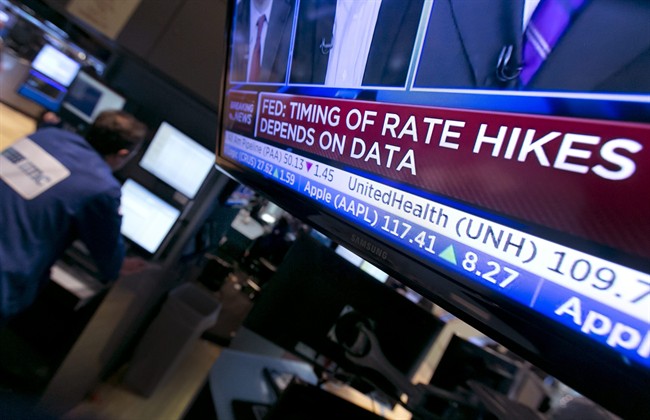WASHINGTON – For seven years — through political fights, Europe debt crises and market panic — borrowers and investors could count on one thing: Short-term U.S. interest rates would stay locked near zero.

Such was the will of the U.S. Federal Reserve, which remained wary of the world’s largest economy’s durability long after the gravest recession since the 1930s had ended.
Now, with a vastly strengthened economy, the Fed is weighing whether to start phasing out the era of “easy money” as soon as Thursday. It would be its first rate hike since 2006. Awaiting the decision, markets have been gripped by tension.
Ask some economists, and they’ll tell you now is the time for a hike. Not so soon, others say. Here’s the case for a rate hike now — and the case for delaying it.
WHY RATES SHOULD BE HIKED NOW
What’s the Fed waiting for?
- Trudeau tight-lipped on potential U.S. TikTok ban as key bill passes
- Canadian man dies during Texas Ironman event. His widow wants answers as to why
- Hundreds mourn 16-year-old Halifax homicide victim: ‘The youth are feeling it’
- On the ‘frontline’: Toronto-area residents hiring security firms to fight auto theft
The U.S. economy keeps expanding, and employers keep hiring: They’ve added 12.6 million jobs since 2010 — far beyond the 8.7 million lost to the Great Recession. The unemployment rate is 5.1 per cent. It hasn’t been that low in seven years. Cars are flying off lots at the fastest pace since 2001.
Home purchases have regained their pre-recession levels. Americans are flocking to trendy new eateries, lifting restaurant and bar sales a healthy 9 per cent in the past year.
“And here we are worrying about whether the economy could possibly withstand a quarter-point hike,” says Paul Ashworth, an economist at Capital Economics, a forecasting firm.
Critics argue that by continuing to pin the rate it controls at a record low long after the economic crisis has faded, the Fed remains oddly in a state of emergency. In 2008, when it first slashed its rate to near zero, the financial system was teetering. The economy was hemorrhaging jobs. Unemployment would soon hit 10 per cent. Big banks and car companies needed bailouts.
Since those dark days, individuals and companies have repaired their finances. They may no longer need ultra-low rates to borrow and spend.
WHY THE FED SHOULDN’T HIKE NOW
Why put the economy at unnecessary risk?
That’s the fundamental argument against a Fed rate hike now: In light of fear about China’s weakening economy and anxiety in financial markets, some analysts argue, why not play it safe until the picture brightens?
The usual factors that compel a rate hike — signs of an overheated economy building inflation pressures, for example — are nowhere to be found. Not yet, anyway. Keeping the Fed’s benchmark at record lows might further support borrowing, spending and growth.
That’s why Christine Lagarde, managing director of the International Monetary Fund, has implored the Fed to wait.
“The economy would be better off with a rate hike in early 2016,” Lagarde said in June.
Lagarde and like-minded Fed watchers worry about the risk that a rate hike would prove premature — and end up damaging the economy. They feel that that risk outweighs the possibility that the Fed might wait too long to raise rates and cause inflation to rise too fast.
Consider what happened when an impatient European Central Bank hiked rates in 2011, two years after a devastating downturn. The countries that share the euro currency tumbled back into recession. The ECB has since reversed course and begun pumping money into the European economy to try to revive growth.
Might the Fed risk the same mistake?
— With a file from Global News

Comments